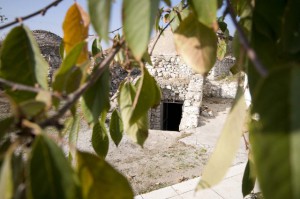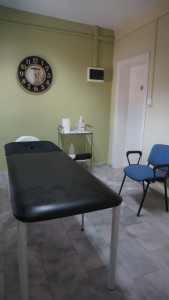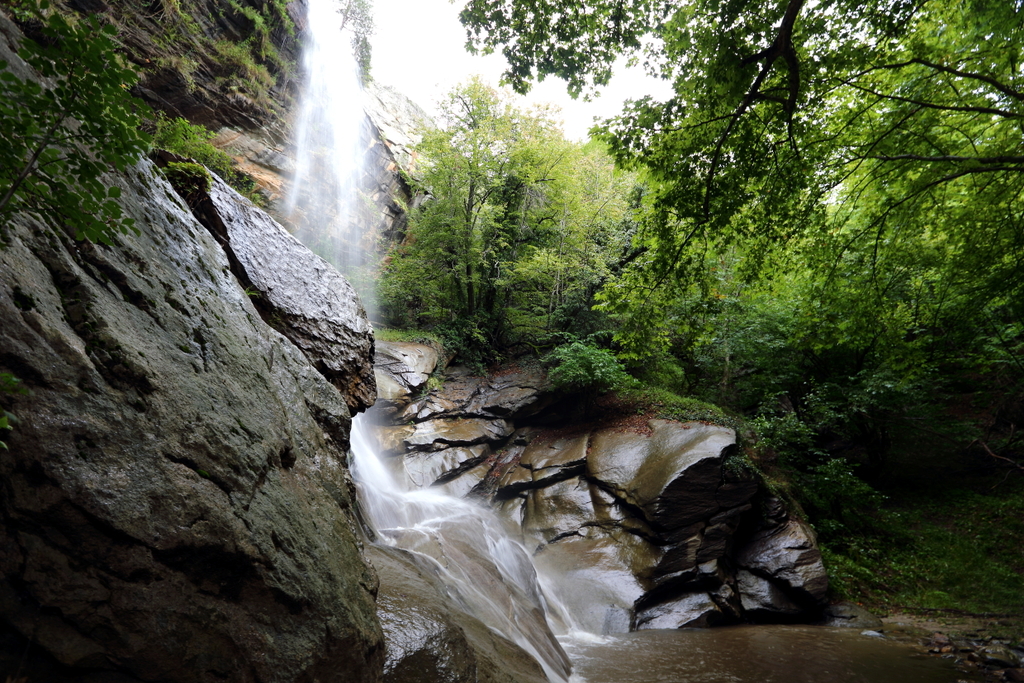 The hot curative springs of Traianoupoli were a major attraction from ancient times. The city of Traianoupoli was built by the Roman emperor Traianos in the beginning of the 2nd century A.D. According to tradition, Traianos (106/7 A.D.) on his way to and from war for Dakia created “agores”. He founded schools, libraries, baths (thermae). The foundation of Traianoupoli fell within the reconstruction programme of the Roman state; there is written testimony for the location of Traianoupoli by the geographer Klaudios Ptolemy of Alexander in his work “Geographia”.
The hot curative springs of Traianoupoli were a major attraction from ancient times. The city of Traianoupoli was built by the Roman emperor Traianos in the beginning of the 2nd century A.D. According to tradition, Traianos (106/7 A.D.) on his way to and from war for Dakia created “agores”. He founded schools, libraries, baths (thermae). The foundation of Traianoupoli fell within the reconstruction programme of the Roman state; there is written testimony for the location of Traianoupoli by the geographer Klaudios Ptolemy of Alexander in his work “Geographia”.
The old baths are comprised by two domed buildings of the 16th century, each having a tank and locker rooms. The new baths began to be built in 1962 and were completed in 1964. They are located in the historic site of Traianoupoli, on the National Road,at a distance of 14 km from Alexandroupoli, on the way to the Greek- Turkish borders. Today, they are managed by the Tourist Curative Company of the municipality of Alexandroupoli.
 Curative Water
Curative Water
The water of the spring has a temperature of 51- 52ο C
Characterisation: Superheated Cl- Na- Ca- K- B-HS hypotonic, slightly radioactive curative water of municipality of Alexandroupoli.
Therapeutic Indications:
Balneotherapy for ailments of the integumentary system and the musculoskeletal system, as well as for rheumatisms and autoimmune diseases.Mineral water drinking therapy for ailments of the gastrointestinal system.Inhalation therapy for infections of the upper respiratory system.
Health thermalism facilities
The facilities in the thermal city are heated by the hot water thus keeping the environment healthy and pleasant. The thermal city has a hydrotherapy centre with 15 bathtubs and 7 jacuzzi tubs. The temperature of the water ranges between 36- 37ο C. Also, it has accommodation and eating facilities. The baths are open throughout the year. In winter, the baths are open from 10:00 am to 18:00 pm and in summer from 07:30 am to 19:30 pm.
Spring’s Website: www.tieda.gr
Source: www.thermalsprings.gr
 The curative spring of Thermia Paranestiou of Drama gushes in an alternating environment, clean and healthy, with lush vegetation and excellent climate conditions. The curative spring is at a distance of 25 km north of Paranesti and the old stone hydrotherapy centre testifies the human presence throughout the centuries. The area is ideal for nature lovers, as it offers routes and excursions to nature. Moreover, in Paranesti there is a museum of natural history, which offers its visitors a unique chance to acquaint themselves in many ways with the impressive natural environment of Rodopi and the Nestos valley.
The curative spring of Thermia Paranestiou of Drama gushes in an alternating environment, clean and healthy, with lush vegetation and excellent climate conditions. The curative spring is at a distance of 25 km north of Paranesti and the old stone hydrotherapy centre testifies the human presence throughout the centuries. The area is ideal for nature lovers, as it offers routes and excursions to nature. Moreover, in Paranesti there is a museum of natural history, which offers its visitors a unique chance to acquaint themselves in many ways with the impressive natural environment of Rodopi and the Nestos valley.
 Curative Water
Curative Water
The water that gushes from the spring has a temperature of 54ο C
Characterisation:Superheated Νa-Ca-ΗCΟ3-Κ-Li-Βr-F-CΟ2 low in carbon, hypotonic, slightly radioactive curative water of the municipality of Paranesti.
Therapeutic Indications:
Balneotherapy for the ailments of the musculoskeletal system, rheumatism, autoimmune diseases, as well as in cases of mild peripheral obstructive vasculopathy. Mineral water drinking therapy for the gastrointestinal and the urinary system.
 There are no thermalistic facilities. Efforts are being made for the hydrotherapy centre to open.
There are no thermalistic facilities. Efforts are being made for the hydrotherapy centre to open.
Website: www.paranesti.gr
Source: www.thermalsprings.gr
 Samothraki – the Aeolus’s island according to mythology- is a mystical place. The pebbly beaches, the running waters, the unspoilt nature, the celebrated curative springs and unique antiquities compose an idyllic scenery that is breathtaking and fascinating. The hot curative springs are situated at the entrance of the Therma settlement. In Samothraki, visitors, aside from treatment, will be acquainted with archaeological and historic sites, but also with the unique “lagoons” of cold water.
Samothraki – the Aeolus’s island according to mythology- is a mystical place. The pebbly beaches, the running waters, the unspoilt nature, the celebrated curative springs and unique antiquities compose an idyllic scenery that is breathtaking and fascinating. The hot curative springs are situated at the entrance of the Therma settlement. In Samothraki, visitors, aside from treatment, will be acquainted with archaeological and historic sites, but also with the unique “lagoons” of cold water.
 Curative Water
Curative Water
The temperature of the water that gushes from the spring is around 100ο C
Characterisitcs: Superheated Cl- Na- Ca- K – B- Br- J hypotonic, slightly radioactive curative water of the municipality of Samothraki.
Therapeutic Indications:
Rheumatoid arthritis, chronic rheumatisms, gynecological ailments, peripheral vasculopathies, secondary skin ailments, obesity
Health thermalism facilities
The baths are located at the foot of Psarotherma hill. They have two pools (men and women) and 13 individual tubs. The temperature of the water in the men’s pool is 40-41ο C and in the women’s 38-39ο C. The facilities are open from June to October and from 09:30 am to 13:30 am and from 17:30 pm to 23:45 pm.
Source: www.thermalsprings.gr
 The health place of krinides, with its therapeutic clay and curative water, geographically belongs to a wider area with rich history that begins with the foundation of the city in 360 B.C. One of the most important archaeological sites of eastern Macedonia is situated in Krinides, Kavala. In this historic region one can come across the ancient thermae, the ancient agora, the ancient theatre of Filippoi, Lydia’s place of baptism, the first Christian woman in Europe. So the visitor has the possibility to combine his physical and mental health and well-being with an archaeological tour, a journey through history and time.
The health place of krinides, with its therapeutic clay and curative water, geographically belongs to a wider area with rich history that begins with the foundation of the city in 360 B.C. One of the most important archaeological sites of eastern Macedonia is situated in Krinides, Kavala. In this historic region one can come across the ancient thermae, the ancient agora, the ancient theatre of Filippoi, Lydia’s place of baptism, the first Christian woman in Europe. So the visitor has the possibility to combine his physical and mental health and well-being with an archaeological tour, a journey through history and time.
Curative Water
The water that gushes from the spring has a temperature of 29oC. It is suitable for hydrotherapy, in the form of balenotherapy and water mineral drinking therapy.
Characterisation: Tepid Ca- Mg- HCO3 hypotonic curative water
Therapeutic Indications:
Balneotherapy for the ailments of the musculoskeletal system. Mineral water drinking therapy for the gastrointestinal and urinary system.
Therapeutic Clay
The therapeutic clay of krinides is the result of natural, biochemical, geochemical and biological procedures that took place in the area of the clay therapy centre, between a solid element, argil, a liquid element, hot mineral water, and an organic element from the plant world. The temperature of the clay reservoirs is 29ο C.
Characterisation: Peaty, argilic, organic therapeutic clay
 Therapeutic Indications:
Therapeutic Indications:
Autoimmune diseases, rheumatisms and skin ailments.
Health thermalism facilities
The thermal city has a clay therapy centre, with two group tubs of clay for men and women and a hydrotherapy centre. The hydrotherapy centre is housed in a post byzantine building (old Turkish bath). The facilities are open from the 1st of June to the 15th of October, seven days a week from 08:30 am to 18:00 pm. Visitors can also find accommodation in the premises.
Source: www.thermalsprings.gr
 Loutraki baths (Pozar) are located in the municipality of Almopia, 13 km northwest of Aridaia. The word “pozar” means ember, burning coal. The area of the Pozar Baths is a natural sight, located in a green environment with plane trees and waterfalls. Tile paved paths and constructed wooden bridges aid the visitor follow the mountain paths and reach the complex of the 16 caves.
Loutraki baths (Pozar) are located in the municipality of Almopia, 13 km northwest of Aridaia. The word “pozar” means ember, burning coal. The area of the Pozar Baths is a natural sight, located in a green environment with plane trees and waterfalls. Tile paved paths and constructed wooden bridges aid the visitor follow the mountain paths and reach the complex of the 16 caves.
The open pool and the “ponds”, which are naturally shaped in the bank of the hot river, offer the chance of bathing in a fascinating natural scenery. The visitors come to the baths from every corner of Greece either to receive the beneficial properties of the curative waters (therapeutic – relaxing), or to escape in the beautiful mountains with the caves.
 Curative Water
Curative Water
The hot springs gush for the bank of the hot river, with a temperature that reaches 37ο C
Characterisation: Homotherm HCO3- Ca- Mg- K- B- As hyponotic, slightly radioactive curative water of the municipality of Almopia.
Therapeutic Indications: Balneotherapy for rheumatisms, arthritis, ailments of the peripheral nerves, gynecological and skin ailments, sprains, fractures
Health thermalism facilities:
In the new hydrotherapy centre there are private pools, each functioning separately. Their dimensions are 3×3, 1.50 metres deep and temperature of 37 degrees. In the Old Hydrotherapy Centre there are 2 pools with dimensions 3×6 and with a temperature of 37 degrees and 2 smaller pools (Turkish bath like) with a temperature of 38 degrees. Moreover, there are 2 outdoor waterfalls, one of them having a temperature of 37 degrees and the other, which is mixed with cold water, has a temperature of 30 degrees. There is also an outdoor olympic – sized pool with a temperature of 37 degrees in the snack bar area. There are locker rooms in every space.
What’s more, in the area of the thermal city there is a hotel with 10 double rooms and 2 triple rooms and a restaurant as well. It is open the whole year round, day and night.
Springs’ Website: www.loutrapozar.com.gr
Source: www.thermalsprings.gr
 The thermal city of Potamia is situated at the 18th kilometre of the road Xanthi – Komotini. People of the intellect, the arts and literature, like Dimokritos, Protagoras, Leykippos were born and thrived in the historical area of Avdira. In a small distance, lies Vistonida lake, one of the most important wetlands of Greece and a little further is the picturesque port of Porto Lagos. The visitor can combine balneotherapy, with a visit to the Archaeological and Folklore museum of Avdira and go round the picturesque roads of the traditional settlement of Avdira.
The thermal city of Potamia is situated at the 18th kilometre of the road Xanthi – Komotini. People of the intellect, the arts and literature, like Dimokritos, Protagoras, Leykippos were born and thrived in the historical area of Avdira. In a small distance, lies Vistonida lake, one of the most important wetlands of Greece and a little further is the picturesque port of Porto Lagos. The visitor can combine balneotherapy, with a visit to the Archaeological and Folklore museum of Avdira and go round the picturesque roads of the traditional settlement of Avdira.
Curative Water
The water that gushes from the spring has a temperature of 55-70ο C
Characterisation: Superheated Na-Cl-HCO3-K-B-As-F –acidic, hypotonic, slightly radioactive curative water of the municipality of Avdira
 Therapeutic Indications:
Therapeutic Indications:
Chronic rheumatisms, gynecological ailments, neuralgia, neuritis, allergic skin ailments
Health thermalism facilities:
The thermal city has hydrotherapy facilities, with two group tubs for men and women. The temperature in the tubs ranges between 39-41ο C.The baths operate from May to January and between the hours 08:30 am – 19:00 pm, except Sunday.
Source: www.thermalsprings.gr
Loutrohori is built on the foot of mount Kamper, on the borders between the prefectures of Pella and Imathia and has an altitude of 90 metres. The beautiful pine forest of the village and the panoramic view of extraordinary beauty that the foot of the hill offers to the tree- covered plain, compose a magnificent scenery.
In Loutrohori there are the homonymous curative springs, known throughout Greece for their various therapeutic properties. In the past, they functioned with visitors from different parts of Macedonia mainly for skin ailments.
Curative Water
The temperature of the water is 18ο C
Characterisation: Cold HCO3-Na- Ca- Cl- Mg- HS- B- K hypotonic, slightly radioactive curative water of the municipality of Skydra.
Therapeutic Indications:
Ailments of the digestive system, skin, lung and musculoskeletal ailments
Source: www.thermalsprings.gr
Agkistro village is built on the Greek- Bulgarian borders, east of the valley of Strymonas. It is an exceptional alternating scenery, serene with lush vegetation and ideal climate conditions. During the reign of Filippos 2nd of Macedonia (4th century B.C.), mines of iron and gold operated in the Agkistro mountain, which along with Paggaio, funded the Alexander ‘s the Great Panhellenic campaign to Asia against the Persians. The hot springs of Agkistro have always been visited by people throughout the centuries.
Curative Water
The temperature of the gushing water from the spring is 34- 39o C.
Characterisation: Superheated Na – Ca- K- SO4– HCO3-F hypotonic, slightly radioactive curative water of the municipality of Sintiki.
Therapeutic Indications:Rheumatisms, arthritis
Health thermalism facilities
Visitors can enjoy their bath in the byzantine tub, which was built around 950 A.D. Three big hydrants supply the historic group tub with an abundant flow of hot water. Five individual tubs also operate. The temperature of the water in the tubs is 38o C. It is open the whole year round, seven days a week, 24 hours a day. The abundance of the hot curative water, the pleasant environment and the accommodation facilities, compose a place of care for human health and well-being.
Source: www.thermalsprings.gr
 The curative baths are located seven kilometers west from the city of Sidirokastro. The curative springs are known from byzantine times, but the old facilities were ruined during the Balkan wars. In this area one may combine the care of one’s health with a visit to the byzantine castle, Kerkini lake, Rupel fortress and the bridge of the Strimona river where Hercules completed the feat with “Gironi’s oxen”.
The curative baths are located seven kilometers west from the city of Sidirokastro. The curative springs are known from byzantine times, but the old facilities were ruined during the Balkan wars. In this area one may combine the care of one’s health with a visit to the byzantine castle, Kerkini lake, Rupel fortress and the bridge of the Strimona river where Hercules completed the feat with “Gironi’s oxen”.
Curative Water
The temperature of the water is 43, 7- 55ο C
Characterisation: Superheated Na- Ca- K- HCO3- F-B hypotonic curative water of the municipality of Sintiki
Therapeutic Indications: Rheumatisms, spondylitis, spilled disc, neuralgia, myalgia, sciatica, joint ailments, gynecological ailments
Health thermalism facilities
A byzantine bath, 3 jacuzzi pools and 12 individual tubs operate in the hydrotherapy centre of the baths, while aromatherapy, chocolate therapy and clay therapy is provided. The temperature of the water in the facilities is 40-42oC. The baths remain open during the whole year, seven days a week and 24 hours a day. In the area, there is a hotel with a restaurant and other facilities for the care of the visitors.
Springs’ Website: www.spa.gr
Source: www.thermalsprings.gr
 In the valley of Mygdonia, in a green oasis of 100 acres and only 2 kilometres east of the city of Lagadas, lie the homonymous curative baths. The evolution of the baths of Lagada is directely connected with the history, the social conditions, the traditions and the culture, as they were formed through the ages.
In the valley of Mygdonia, in a green oasis of 100 acres and only 2 kilometres east of the city of Lagadas, lie the homonymous curative baths. The evolution of the baths of Lagada is directely connected with the history, the social conditions, the traditions and the culture, as they were formed through the ages.
The first balneotherapy facilities in the region of Lagadas are dated back to 900 A.D. and tradition has it that the baths were created by the byzantine military doctor Ioustinianos. Today, two byzantine tanks from the years 900 and 1400 A.D. remain and are still used. Geographers and travellers in 1670 A.D. mention the byzantine facilities, with a special reference to the “magnificent marble group tub”. The systematic organisation of the baths began in 1925 and today Lagadas is a big and modern thermal city.
Curative Water
The temperature of the curative water is 39ο C.
Characterisation: Hot Na- Ca- K- SO4- HCO3- F hypotonic, slightly radioactive
Therapeutic Indications: Balneotherapy for rheumatisms, arthritis, gynecological ailments, skin ailments, kidney problems. Mineral water drinking therapy for ailments of the gastrointestinal and urinary system.
Health thermalism facilities
The thermal city of Lagadas has two byzantine tubs, which date back to the 900 and 1400 A.D., two modern group tubs, 21 individual jacuzzis and 20 personal tubs. Face and body treatments, beauty and rehabilitation cares, personally adjusted for the needs of the visitors were created based on the curative water. The facilities are open throughout the year, seven days a week. In summer, it is open from 07:00 am to 23:00 pm and in winter from 08:00 am to 01:00 pm. In the thermal city there is a hotel and a restaurant.
Spring’s Website: www.loutralagada.gr
Source: www.thermalsprings.gr
- 1
- 2

















































































